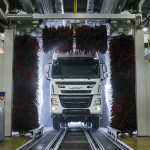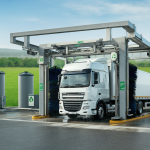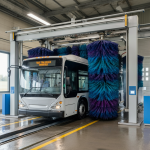The ripple effects of government tariffs extend far beyond political headlines—they can shape industries, redefine business costs, and influence critical operational decisions. For leaders in the truck wash equipment space, this is especially concerning. If you’re a fleet manager, vehicle maintenance professional, or truck wash owner, understanding how tariffs affect your business is essential.
This blog unpacks the potential effects of Trump’s tariffs on the cost of building truck wash equipment, ranging from raw material price hikes to shipping delays. Stick around to learn insights from industry experts, strategies to mitigate rising costs, and predictions for the long-term future of the industry.
How Tariffs Shape the Manufacturing Industry
Before we focus on truck wash equipment, it’s important to understand the broader context of tariffs in manufacturing. Tariffs are essentially taxes placed on imported goods. Governments, such as Trump’s administration, introduce tariffs intending to protect domestic industries or push back against trade imbalances. However, this often leads to unintended consequences.
When tariffs are applied, the cost of raw materials increases. For manufacturers, this directly impacts production expenses. These higher costs are often passed down to consumers of finished products, creating a domino effect that spans entire supply chains. Manufacturers of niche or specialized equipment, like truck wash systems, are no exception.
What Makes the Truck Wash Equipment Market Unique?
The truck wash equipment market is a niche but critical part of fleet maintenance. High-quality truck wash systems ensure that fleets remain compliant with road regulations, enhance brand image, and increase vehicle lifespan.
The market operates within specific constraints:
- Heavy reliance on materials: A significant portion of truck wash systems is built using steel, aluminum, and other industrial-grade materials—most of which are subject to tariffs.
- Precision machinery: Truck wash systems often include advanced technology like sensors, computer automation, and water recycling mechanisms. Components for these may also be subject to import tariffs.
- High upfront costs: Given the customization and features involved, truck wash equipment isn’t cheap. Even a small increase in manufacturing costs can create significant sticker shock for potential buyers.
What Are Trump’s Tariffs and How Do They Affect Truck Wash Equipment?
The tariffs introduced under the Trump administration have focused on materials like steel and aluminum, as well as products imported from countries like China. Here’s how different aspects of these tariffs affect truck wash equipment:
1. Steel and Aluminum Tariffs
Truck wash equipment requires durable materials to withstand frequent use and harsh environments. Unfortunately, U.S. tariffs on imported steel and aluminum have caused significant price spikes in these materials—and the effects are ongoing. A 25% tariff on steel, for example, raises the baseline cost of production, which trickles down the supply chain to businesses purchasing truck wash systems.
2. Electronic Components and Specialized Parts
Many advanced truck wash systems rely on electronic components and specialty parts sourced internationally. Tariffs on Chinese imports, for instance, have escalated costs for components like sensors, control panels, and water recycling systems. With limited local manufacturing options, businesses often have no choice but to bear these higher costs.
3. Supply Chain Delays
Beyond cost increases, tariffs disrupt global supply chains. Import restrictions lead to slowed shipping timelines, making it harder for manufacturers to deliver products on schedule. For truck wash owners planning installations, these delays can be a huge operational headache.
What Are Industry Experts Saying?
To better understand the situation, we’ve gathered insights from industry stakeholders:
- John Peterson, CEO of an Equipment Manufacturing Firm: “The steel tariffs have been the hardest to manage. You can’t produce industrial-grade systems without paying top-dollar for materials. This has led us to re-evaluate supplier relationships and experiment with sourcing more domestically.”
- Emily Cox, Fleet Maintenance Consultant: “Businesses just see the end price when purchasing new systems, but a lot of these increases stem from tariffs manufacturers are struggling to absorb right now.”
- Small Truck Wash Owner in Texas: “We’re already a small operation. If I upgrade my equipment, I’ll need to rethink my pricing model for customers to ensure I stay profitable.”
These perspectives underscore how wide-reaching the effects of tariffs can be for both manufacturers and end users in the truck wash industry.
How to Mitigate Costs in a Changing Market
The good news? There are strategies businesses can use to manage the increasing costs associated with tariffs:
1. Consider Refurbished Systems
Buying high-quality used truck wash equipment could save you money during periods of high material costs. Look for options with warranties or support services to ensure long-term functionality.
2. Explore Domestic Suppliers
Some manufacturers are pivoting to domestic suppliers to avoid tariff-related price hikes on imported materials. Ask your vendor whether they’re able to source materials or components locally.
3. Optimize Maintenance on Existing Equipment
Preventative maintenance is more critical than ever. Extending the lifespan of your current truck wash system helps delay the need for capital investment until tariffs stabilize.
4. Plan Purchases Strategically
Hold off on smaller, impulse buys, and focus on larger, bundled purchases at discounted rates if possible. Many vendors may offer volume-based discount structures.
5. Collaborate with Vendors
Communicate regularly with your equipment suppliers. They may have creative solutions or alternative models that better fit your budget constraints.
Looking Ahead: What Will the Future Hold?
While it’s impossible to predict policy changes with certainty, here are some potential long-term outcomes for the truck wash equipment industry if tariffs remain in place:
- Higher Standard Prices: Increased raw material costs could push standard pricing up permanently, normalizing higher capital expenditure for truck wash systems.
- Shift Toward Automation: To counter rising labor and material expenses, manufacturers may accelerate investments in automation.
- Greater Innovation: To stay competitive, manufacturers may begin exploring alternative materials or engineering techniques that lower production costs.
That said, some relief might come as alternative trade agreements are negotiated or tariffs are adjusted under future administrations.
How You Can Stay Ahead
Navigating the complexities of tariffs and their effects on the truck wash equipment market requires proactive planning and informed decision-making. Start by understanding where your equipment comes from, how it’s built, and whether costs are likely to rise in the coming months.
Stay connected with industry experts, news, and vendors for updated insights on market developments. If you’re considering a new truck wash system, talk to suppliers early to lock in quotes and explore custom solutions for cost-saving strategies.
Don’t get caught off guard—stay informed and keep your fleet spotless, no matter what obstacles arise.




